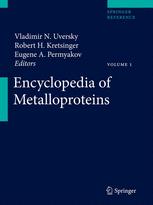

Most ebook files are in PDF format, so you can easily read them using various software such as Foxit Reader or directly on the Google Chrome browser.
Some ebook files are released by publishers in other formats such as .awz, .mobi, .epub, .fb2, etc. You may need to install specific software to read these formats on mobile/PC, such as Calibre.
Please read the tutorial at this link: https://ebookbell.com/faq
We offer FREE conversion to the popular formats you request; however, this may take some time. Therefore, right after payment, please email us, and we will try to provide the service as quickly as possible.
For some exceptional file formats or broken links (if any), please refrain from opening any disputes. Instead, email us first, and we will try to assist within a maximum of 6 hours.
EbookBell Team

5.0
80 reviewsIn biochemistry, a metalloprotein is a generic term for a protein that contains a metal cofactor. The metal may be an isolated ion or may be coordinated with a nonprotein organic compound, such as the porphyrin found in hemoproteins. In some cases, the metal is co-coordinated with a side chain of the protein and an inorganic nonmetallic ion. This kind of protein-metal-nonmetal structure is seen in iron-sulfur clusters
Metalloproteins deals with all aspects related to the intracellular and extracellular metal-binding proteins, including their structures, properties and functions. The biological roles of metal cations and metal-binding proteins are endless. They are involved in all crucial cellular activities. Many pathological conditions are related to the problematic metal metabolism.
Research in metalloprotein-related topics is therefore rapidly growing, and different aspects of metal-binding proteins progressively enter curricula at Universities and even at the High School level on occasion. However, no key resource providing basic, but comprehensible knowledge on this rapidly expanding field exists. The Encyclopedia of Metalloproteins aims to bridge this gap, and will attempt to cover various aspects of metalloprotein/metalloproteomics and will deal with the different issues related to the intracellular and extracellular metal-binding proteins, including their structures, properties and functions. The goal is to cover exhaustively all catalytically and biologically crucial metal ions and to find at least one interacting protein for other metal ions. The Encyclopedia of Metalloproteins will provide a key resource for advanced undergraduate and graduate students, researchers, instructors, and professors interested in protein science, biochemistry, cell biology, and genetics.